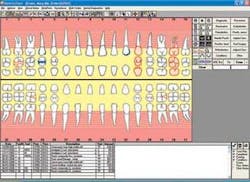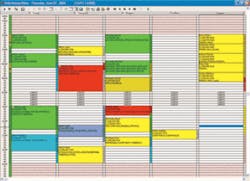How to choose a software company
Choosing the right software company is one of the biggest decisions you will make for your practice. Why? Your choice of software will not only determine your ability to manage your financials, but will, in large measure, affect your overall practice success.
Fortunately, the market currently offers some exciting software technology. When selecting a software company, look at the latest offerings from a variety of companies. Whether you choose software from Dentrix, DentiMax, EagleSoft, SoftDent, or other software vendors, there is a solution that will be the right fit for your office.
When choosing a software company, ask yourself these questions:
① Does the software provide accurate financials?
② What is the software’s total cost?
③Is it a complete system that meets my current and future needs?
④What kind of reporting capability does the software offer?
⑤ Does the flow of the software match my practice workflow?
⑥ Will the software help keep the work schedule full?
⑦ What type of support, training, and learning tools are available?
Software financials
I am always looking for software that offers something new to help dentists more effectively manage their finances. While at this year’s Anaheim CDA Exposition, I reviewed the latest software from DentiMax and was impressed with the way it graphically displayed three major cash-flow indicators, all within a monthly calendar -
1) The true dollar figure that future appointments represent,
2) Current production, and
3) The amount of actual cash the practice has collected. Cash-flow management is an important part of any office, and this software makes it easier.
Too many dentists do not have a good grasp on their practice financials. For example, have you ever looked at your production report to see a healthy daily production total of $6,000, only to find the following month that there was over $2,000 in insurance adjustments for that same day? This is an all too common scenario for many dental offices and is completely avoidable. With the right software features and reports, your practice’s production numbers should rarely change, and entering an insurance adjustment should be rare.
Unless you are a cash-only dental office, make sure that the software provides financial information that accurately estimates the patient’s and the insurance’s portion of a bill. This is the kind of information your office manager needs to collect payments from your patients at the time of service and to send statements before you’ve received your insurance checks.
When evaluating a software program’s financial capability, it’s a good idea to print the various financial reports and imagine yourself using these reports to make a decision. Do the software’s financial features give you enough information to determine whether or not you should send a patient to collections, drop a certain insurance plan which consistently pays late, or add another hygiene day?
How to handle patient payment plans is another financial concern for practices. Although most software programs provide financing plans with patient payment options, I recommend against offices using this software feature. Why? For the most part, dental offices make very poor banks, displaying dismal results in collecting money from patient payment plans.
Instead of assuming the burden of financing your patients, consider using a professional finance company such as CareCredit®, Capital One, Wells Fargo, Unicorn Financing Services, E-Z Pay Healthcare, or HELPCard.® These finance companies will extend easy credit to your patients, all within minutes, and will transfer payments to your bank account within days.
Now practices can benefit from outside patient financing programs being integrated into their practice management software. For example, CareCredit is now integrated into SoftDent, PracticeWorks, Ortho Trac, WINOMS, and other Kodak practice-management software programs, as well as Discus Dental® practice-management software and other programs. With a simple click of the mouse, your patient’s information is transferred from the patient screen to the application and submitted. A credit decision is provided almost instantly, so the entire process takes literally seconds.
Most financial companies require patients to borrow a minimum amount before allowing them to participate in their low-interest plans. This means that patients who require financing will want to prepay their entire treatment plan at their first visit. Make sure that your software can handle these types of prepayments. One software program includes an option to display family prepayments at the top of each family member’s ledger. Over time, this amount is decremented as it is applied to each family member’s outstanding balance. Prepayment features like this make professional finance companies much easier to use.
Total software cost
It’s important to understand the software’s total price. This will include add-on fees, recurring fees, maintenance and/or support fees, and other possible fees. An easy way to calculate your total software cost is to acquire a comprehensive price list. You should be able to either find a price list from the Internet or request one directly from the company.
Many software companies not only charge a fee for their software but also require monthly support and maintenance contracts. Often, these recurring fees increase when additional software modules are purchased. For example, you might choose a software company that sells digital X-ray imaging as a separate module. If you later decide to add this module, you may be charged a higher monthly maintenance fee in addition to the original fee for the imaging module.
I recently spoke with a dentist who purchased software that required a monthly maintenance fee. This dentist told me he feels trapped by his software company and that he is hesitant to add any more modules or features to his software program because of the high initial cost and “the ongoing taxation required to pay for the privilege of using it.” The total cost for this dentist is over twice the original amount and is still increasing.
Complete system
Too often, software is purchased that barely covers current practice needs. Do not to lock yourself into a software program with limited possibilities. Once implemented, it can be difficult and costly to switch to a different system.
For example, many practices acquire software that doesn’t offer either clinical or digital-imaging capability. Even if you feel that your practice is not yet ready for these features, make sure the software company at least offers some type of upgrade path to clinical charting, perio charting, and digital imaging.
I have a friend who purchased software that had no clinical or imaging capability. After realizing the benefits that clinical charting and imaging provided, he contacted his software vendor, only to learn that his software company did not provide these features. My colleague ended up purchasing an entirely new practice-management system. Not only was this expensive, but it was time-consuming for him and his staff.
If you decide to implement clinical charting at a later time, make sure you feel comfortable with this part of the software. This is the part you will personally use as a clinician. It is important to note that not all clinical charting systems are the same. Make sure that your charting system lets you easily and quickly enter planned and completed treatments, as well as conditions.
Clinical charting is at its best when combined with digital imaging. There is nothing more efficient than diagnosing and treatment-planning from one screen. And if you consider the cost of chemicals, equipment maintenance, mounts, and your time, you will quickly realize that traditional film-based X-ray imaging is more expensive, cumbersome, and time-consuming when compared to digital imaging. It is a simple fact that digital sensors and imaging software outperform traditional film, as well as expedite and simplify X-ray image processing.
Reporting capability
Whatever software you choose, make sure it provides the specific information you need to properly run your office. Some software companies offer very limited reports and may not offer a specific report that your office needs. For example, your office might experience a time when a string of patients with large treatment cases, for one reason or another, do not complete their treatment. Let’s say your office is heading into a traditionally slow month. Your software had better offer some type of incomplete/unscheduled treatment plan list that your office manager can use to follow up on these patients.
A few software companies now offer complete report writers that can be used to create any report imaginable. This means that if the data is in the software, you have complete access to it. Knowing that many users don’t take the time to learn how to use a report writer, one software company will even create customized reports for a small fee.
Practice/software workflow
Do the features listed in the software’s marketing literature translate into a program that is really going to work for your practice? What appears good on paper may not always make it in the real world! Install a demonstration version of the software on your computer and take it through its paces. Don’t be afraid to ask the vendor hard questions - it’s better to ask questions before you pay money than after you sign a long-term contract. Most importantly, involve your office staff in this critical purchasing decision. The members of your office staff will determine the success of your transition to a new software system. It is always better to get them to “buy in” sooner rather than later.
Like most offices, you probably start and end your day while in your software’s appointment calendar, the all-important screen that displays your scheduled patients. Make sure the appointment screen displays pertinent appointment information in a way that is easily viewed. Information like procedure abbreviations, the patient’s name and phone number, and the current time of day should all be predominately displayed on the appointment calendar. Some programs even give you the ability to customize the information that appears in your patients’ appointments. You might find it important to display the patient’s age and insurance on an appointment while another practice might find the appointment’s creation date a more important item to be displayed.
Assure that there is a nice flow through the software screens and that they are easy to use. When a new patient calls, your office manager will need to set an appointment, add new patient procedures to the appointment, and create a new patient record that is possibly linked to an insurance company. Does the software move intuitively between these information centers? When the new patient checks into the office, does the software have a way to communicate that the patient is ready to be seated? Is there a nice flow of information from the charting screen to the appointment screen and to other areas of the program? Can digital X-rays be easily taken and viewed from within the charting screen? Visualize your office workflow as you go through these types of questions.
Tools to keep your schedule full
Your software should handle all of the various methods for making and tracking appointments. Make sure the software offers a streamlined process for quickly and easily capturing appointment information for new patients as well as for patients of record. After appointments have been created, the software should allow you to track missed and canceled appointments for easy follow-up and rescheduling. Additionally, you need to be able to easily identify patients who are willing to fill these unexpected holes in your schedule.
Your patient recall system will be an important tool for keeping your schedule full. A good patient recall system is the lifeblood for most successful practices. If patients are not recalled for their periodic exams and X-rays, they are not being diagnosed and, more importantly, they are not being treated. When evaluating possible computer software, verify that its recall system is understandable and usable for your office.
Support, training, and learning tools
Place even the greatest software tool into the hands of untrained staff and you may have problems. Software is only as good as the person using it. Some systems are complicated and may require in-depth, on-site training; however, any software system should at least come with a comprehensive manual and easy-to-access help screens. Some software companies offer interactive training tools that will help you and your staff through initial software setup and overall software use. Interactive training CDs and training videos are not only helpful for learning a new system but can be used as refresher courses or to train new staff .
Before you buy any software program, make sure there is someone you can call if you ever need help. Most software companies offer on-site support and training either through their own training department or through one of their local dealers. At a minimum, the software company should offer 1-800 telephone technical support. As part of your software evaluation, call the support line and see how quickly your call is answered. Maybe even ask a few questions to verify that the support staff is able to quickly answer your questions in an understandable way. If they are unable to help you with a simple question before you are a customer, you probably are not going to get good support after you become their customer.
In summary, deciding which software program your office should adopt is not a decision to be treated lightly. From SoftDent, Dentrix, and EagleSoft to new technology from DentiMax, there are some great software programs currently offered on the market. Whatever software you ultimately choose, make sure it fits both your current and future needs, as well as effectively handles your practice’s financials and workflow. Choosing the right software company can be the best decision your practice ever makes.
Major Dental Software CompaniesDentiMax, (800) 704-8494, www.dentimax.com
Dentrix, (800) 336-8749, www.dentrix.com
EagleSoft, (800) 475-5036, www.eaglesoft.net
Softdent, (800) 944-6365, www.kodak.com
PracticeWorks, (800) 944-6365, www.kodak.com
Easy Dental, (800) 768-6464, www.easydental.com




